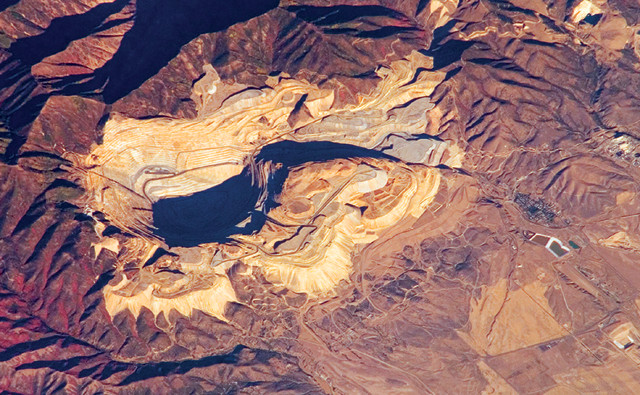
by Julia Rosen Sunday, June 7, 2015

The Bingham copper mine in Utah, one of the largest in the world, exploits a massive porphyry copper deposit. Credit: NASA.
Every year, the world consumes about 20 million tons of copper primarily for construction materials like electrical wiring and water pipes. Most nonrecycled supplies come from porphyry copper deposits (PCDs), which form when hot, metal-bearing fluids percolate up through Earth’s crust. But while geologists have long recognized — and exploited — PCDs, two new studies suggest they may need to rethink how these deposits form.
One of the studies challenges the long-held idea that a single fluid, leaked from a magma chamber, can provide all the necessary ingredients to make a PCD. In addition to copper, such a fluid must also contain substantial amounts of sulfur. Through some chain of events — the subject of the new study — the two elements eventually combine to form copper-sulfide minerals like bornite and chalcopyrite, which trap the metal in the crust.
The problem is that research conducted in active volcanic settings suggests it’s hard to form a fluid that’s both rich in copper and in sulfur, says Jon Blundy, a petrologist at the University of Bristol in England and lead author of the study, published in Nature Geoscience. “The kinds of processes that lead to an enrichment in copper are hard to reconcile with the kinds of processes that lead to an enrichment in sulfur,” he says.
So Blundy and his colleagues developed an alternative model for how PCDs might form. It starts the same way the old model did, with fluids separating from magma and taking copper and chlorine — but not much sulfur — with them. These fluids bubble up through the crust and collect in pores in the rock, where they sit, waiting for the final step that will allow them to form copper minerals. “Think of it like taking a photograph on old photographic paper — the image is there, but if you don’t fix it, it will disappear,” Blundy says.
While conventional thinking holds that changes in temperature, pH or oxidation conditions could cause copper ores to precipitate out of these fluids, the new model suggests this doesn’t happen until later — perhaps much later — when an additional injection of magma supplies a fresh source of sulfurous volcanic gas. This gas rises and mingles with the trapped fluids to form copper-sulfide minerals, a hypothesis borne out by a series of laboratory experiments Blundy’s team designed to test their model.
Few question the results of these experiments, which clearly demonstrate that such a process could occur, but scientists challenge the underlying premises of the study: namely, that there’s a problem with the existing model of PCD formation, and that active volcanic settings might hold the answer. For one, it’s not clear that PCD-forming fluids actually lack sulfur. Measurements of microscopic bubbles in copper-bearing rocks, which are thought to trap residual samples of the fluids that formed them, contain plenty of sulfur, says Jeremy Richards, a geologist at the University of Alberta in Canada.
The copper-rich, sulfur-poor fluids cited by Blundy’s team have been found in active volcanic settings, but others say these conditions may not be relevant to PCDs. “The assumption [in the study] is that the processes going on in volcanic systems — in the shallow environment in volcanoes themselves — are somehow linked to the porphyry-ore forming process,” says Jamie Wilkinson, a geochemist at the Natural History Museum in London. In reality, he says, many scientists think PCDs form when the arc appears to be inactive, at least at the surface, complicating any comparisons.
Regardless of whether PCDs form from one fluid or two, a second study published in Geology provides new insight into a mysterious category of deposits that have only been recognized in recent years.
Traditionally, geologists thought that PCDs formed almost exclusively along subduction zones, which produce plenty of magma with the right chemical composition to make copper deposits. In the last decade, however, scientists have stumbled across PCDs in places like Iran and Tibet that are much too young to have formed when those locations last saw subduction, Richards says. Instead, they seem to have resulted from continental collision, although no one knows exactly how.
The new study suggests that these inexplicable PCDs may actually form as a result of both processes — subduction then collision. Based on samples from numerous deposits in Tibet, researchers argue that subduction there provided an initial supply of copper, but that the metal got trapped at the base of the crust instead of rising. This could happen if the oxygen content in the magma were too low, says lead author Zengqian Hou of the Chinese Academy of Geological Sciences.
During collision, however, remelting at the base of the crust drove the trapped fluids to the surface, where copper minerals precipitated to form PCDs. “This new model explains the spatial overlap and complementary metal endowment between subduction- and collision-related magmas and associated PCDs,” says Hou, who adds that this new understanding could help identify potentially valuable deposits in similar geologic environments.
Richards says the new study complements observations he and others have made while studying collision-related PCDs. “People are filling in the blanks,” he says. And although he says he is skeptical the work will lead to new discoveries — PCDs are large and hard to miss — it does shed light on the magmatic and tectonic processes at work deep underground below continental collision zones.
© 2008-2021. All rights reserved. Any copying, redistribution or retransmission of any of the contents of this service without the expressed written permission of the American Geosciences Institute is expressly prohibited. Click here for all copyright requests.